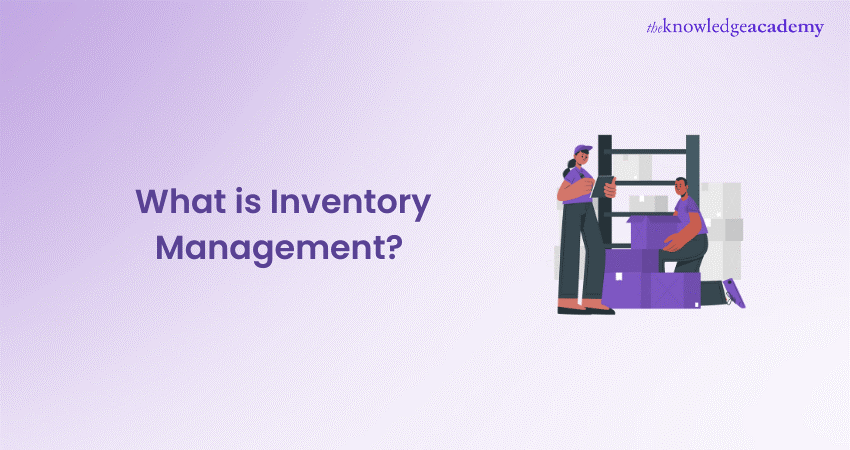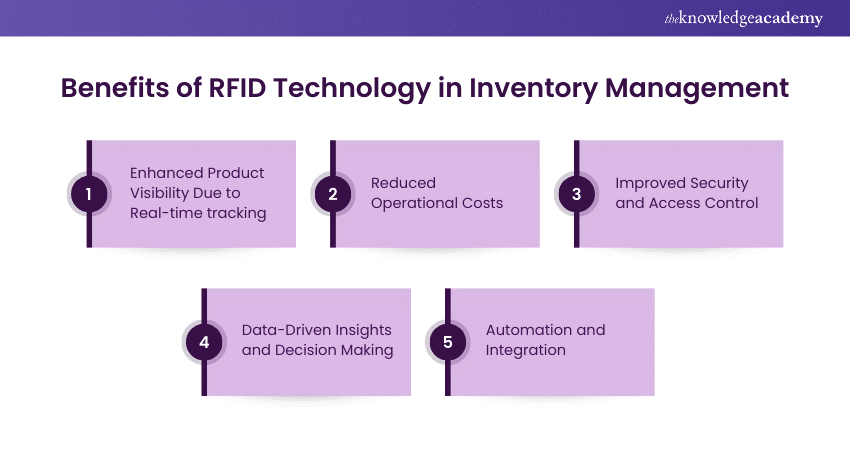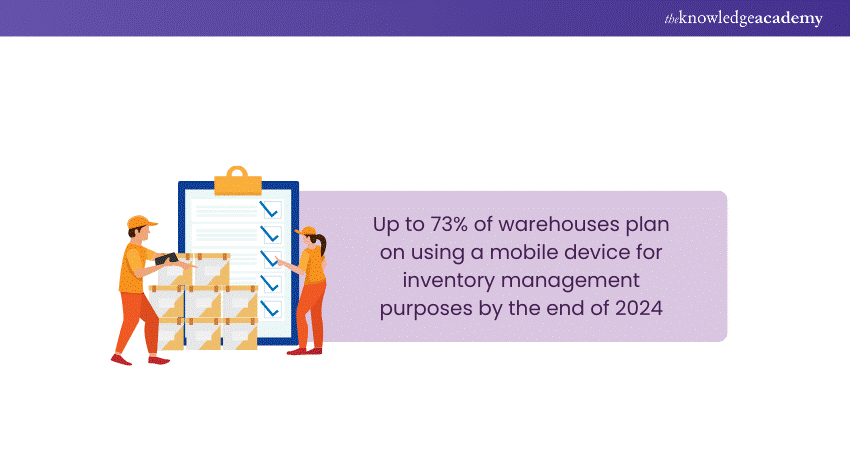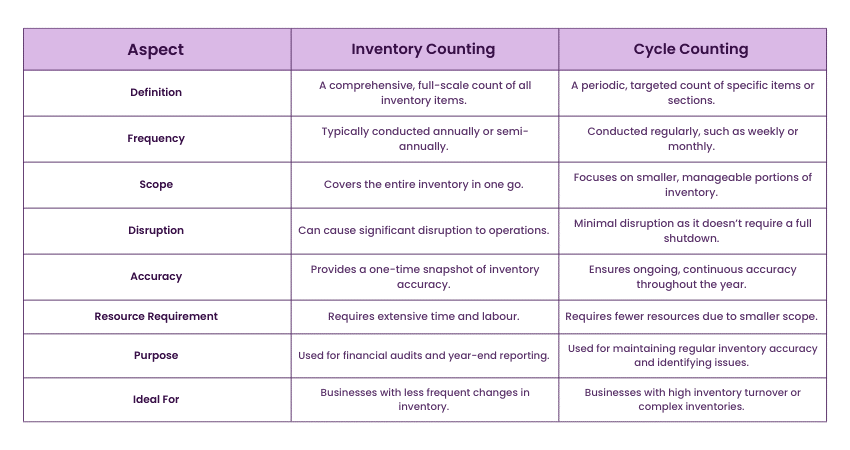We may not have the course you’re looking for. If you enquire or give us a call on +44 1344 203 999 and speak to our training experts, we may still be able to help with your training requirements.
Training Outcomes Within Your Budget!
We ensure quality, budget-alignment, and timely delivery by our expert instructors.

Imagine running a business where you always have the right products at the right time—no instances of overstock or empty shelves! Inventory Management makes that dream possible. It's a strategic balancing act that elevates the mundane process of counting stock and ensures healthy cashflow and improved business efficiency.
From accurately monitoring what’s in your warehouse to mastering the flow of goods, Inventory Management is the key to ensuring satisfied customers, preventing stockouts and reducing excess inventory. If you are seeking some guidance on the same, look no further! This blog illuminates What is Inventory Management and outlines its key features, benefits as well as its future. Let's dive in!
Table of Contents
1) What Is Inventory Management?
2) Types of Inventory Management?
3) Key Features of Inventory Management
4) Benefits of Inventory Management
5) Inventory Management Challenges
6) How Inventory Management Works
7) Inventory Management Methods
8) Inventory vs Cycle Counting
9) Future of Inventory Management
10) Conclusion
What Is Inventory Management?
Inventory Management refers to ordering, storing, using, and selling a company's inventory, including raw materials, components, finished products, and warehousing and processing. Different methods of Inventory Management exist, each with their pros and cons, depending on a company's needs.
A company's inventory is among its most valuable assets. In food services, retail, manufacturing, and other inventory-intensive sectors, inputs such as raw materials and finished products are the core of a company's business. An inventory shortage can be highly detrimental when and where it's needed.
Types of Inventory Management
There are three major types of Inventory Management as detailed below:
1) Periodic Inventory Management: This inventory valuation method involves performing a physical inventory count at specific intervals. It takes inventory at the beginning of a period, adds new purchases, and deducts ending inventory to calculate the cost of goods sold (COGS).
2) Bar Code Inventory Management: Bar code Inventory Management systems assign a number to each product a business sells. This system allows them to associate a comprehensive range of data points with the number, including the product dimensions, weight, supplier, and even variable data, such as the current stock.

3) RFID Inventory Management: RFID stands for Radio Frequency Identification. It's a technology that wirelessly transmits a product's identity as a unique serial number. It tracks items and offers detailed product information. A warehouse management system based on RFID can increase efficiency and inventory visibility and ensure the rapid self-recording of receiving and delivery.
Become a master at management techniques for global procurement and supply chains with our comprehensive CIPS Level 6 Professional Diploma in Procurement and Supply Course - Sign up now!
Key Features of Inventory Management
Key features of effective Inventory Management include:
1) Inventory Tracking: This involves knowing exactly where the inventory is across the supply chain.
2) Order Management: It includes customising pricing, sending quotes, tracking orders, and managing returns.
3) Transfer Management: This involves moving the product to where it's most valuable.
4) Reporting and Analytics: This is about evaluating process patterns to forecast future sales and demand.
5) Purchasing: This is about creating and managing purchase orders.
6) Shipping Capabilities: This feature involves automating shipping to reduce errors such as delivering incorrect packages or late deliveries.
Benefits of Inventory Management
Inventory Management offers numerous benefits, including:
1) Lowering costs and saving money
2) Preventing overspending on warehouse storage
3) Minimising storage needs
4) Reducing losses to improve cash flow
5) Forecasting sales trends
6) Keeping customers satisfied with timely deliveries
7) Identifying consumption patterns to stock the right things
8) Offering a more expansive room for necessary products

Inventory Management Challenges
The primary challenges of Inventory Management involve having excess inventory and not being able to sell it, having insufficient inventory, and not understanding what items the company have in inventory and where they’re located. Other challenges include:
1) Getting Accurate Stock Details: Without accurate stock details, you cannot know when to refill stock or which stock moves well.
2) Poor Processes: Outdated processes can make work error-prone and slow down operations.
3) Changing Customer Demand: Customer tastes change constantly. If your system can’t track trends, you'll never know when and why their preferences change.
4) Using Warehouse Space Well: Staff will waste a lot of time if products are hard to locate in a warehouse.
Looking to lay a strong foundation in the field of procurement and supply? Our CIPS Level 2 Certificate in Procurement and Supply Operations Course will guide you - Sign up now!
How Inventory Management Works
If production is based on demand, the Inventory Management process begins the moment a company receives a customer order and continues until the order is delivered. Otherwise, the process commences when the demand is forecasted, and POs are placed for the required raw materials. The process also includes analysing sales trends and organising warehouse product storage.
Inventory Management aims to understand stock levels and stock’s location in warehouses. Inventory Management software monitors the flow of products from suppliers to the customer. It tracks warehouse stock receipt, picking, packaging, and shipping.
Inventory Management Methods
Depending on the business type or the product involved, a company may use different Inventory Management methods. These include materials requirement planning (MRP), just-in-time (JIT) manufacturing, economic order quantity (EOQ), and days sales of inventory (DSI). These are the four most common methods of managing inventory, as detailed below:
1) Just-in-Time Management (JIT)
This Inventory Management model originated in Japan in the 1960s and 1970s, and Toyota Motor is credited with contributing the most to its development. JIT enables companies to save significant money and reduce waste by purchasing and keeping only the necessary inventory and sell products within a specific time frame. This approach reduces costs for storage and insurance and the cost of liquidating excess inventory.
2) Materials Requirement Planning (MRP)
This is a sales-forecast-dependent Inventory Management method in which manufacturers depend on detailed sales records to anticipate their inventory requirements and communicate those needs to suppliers promptly.
For example, a ski manufacturer utilising MRP inventory system might want to ensure that materials such as fibreglass, wood, plastic, and aluminium are in stock based on forecasted orders.
3) Economic Order Quantity (EOQ)
This model determines the number of units a company must add to its inventory with each batch order to reduce its total inventory costs while assuming constant consumer demand. The EOQ model oversees that the right amount of inventory is ordered per batch so a company does not have to make frequent orders and has no excess inventory at hand.
4) Days Sales of Inventory (DSI)
This is the financial ratio that indicates the average time a company consumes in turning its inventory into sales, including those goods that are a work in progress. DSI is also known as days inventory outstanding (DIO), the average age of inventory, days in inventory (DII), days sales in inventory, or days inventory and is interpreted in multiple ways.
This figure represents how many days a company's current inventory stock will last. A lower DSI is desirable because it indicates a shorter duration to clear the inventory, though the average DSI may vary from industry to industry.
Inventory vs Cycle Counting
The main differences between inventory counting and cycle counting are:
1) Physical inventory counts every stock in a building (usually once or twice a year). Cycle counting counts small, preselected sections of inventory multiple times a year (sometimes as often as daily).
2) Physical inventory counting is done less frequently, whereas cycle counting is performed at regular intervals for different items.
3) Physical inventory counting is the ideal choice for companies with minimal inventory.
4) Cycle counting involves regularly counting specific products, batches, locations, or stock conditions. Its purpose is to ensure that the Inventory Management system accurately reflects the actual stock on the shelves.
This table summarises the key distinctions between the two:

Future of Inventory Management
New technology, globalisation, and empowered consumers are changing how businesses manage inventory. In the future, supply chain operators will use technologies that provide deeper and quicker insights into improving supply chain performance, and anticipate anomalies in performance and logistics costs and before they occur. In the future, the following technologies will transform Inventory Management:
1) Artificial Intelligence: Self-correcting, intelligent, AI will make inventory monitoring more accurate and significantly reduce material waste.
2) Internet of Things (IoT): Data from IoT sensors will offer insight into inventory status and location.
3) Blockchain: Disparate parties can connect through a unified and immutable transaction record.
4) Intelligent Order Management: Supply chains will expand inventory visibility with enhanced demand forecasting and automation.
5) Quantum Computing: Unprecedented computational power will solve previously unsolvable inventory-related problems.
Conclusion
Understanding What is Inventory Management is the foundation for a successful business. Whether you are a startup or an established business, effective Inventory Management is the gateway to greater data-driven decisions, efficient scaling, and streamlined operations. With technology such as blockchain and Artificial Intelligence (AI) being integrated into diverse aspects of business operations, Inventory Management will become more efficient in the future.
Looking to learn how to track and value inventory for better financial management? Sign up for our Inventory Accounting and Costing Course now!
Frequently Asked Questions

While FIFO assumes that the oldest inventory units are sold first, LIFO assumes that the most recent ones are sold first. Additionally, FIFO better reflects current market prices. On the other hand, LIFO matches current costs with revenue and offers a hedge against inflation.

To reduce excess inventory, try out the following strategies:
a) Implement agile Inventory Management.
b) Explore donations and recycling.
c) Diversify sales channels.
d) Run targeted promotions.
e) Optimise product bundling.

The Knowledge Academy takes global learning to new heights, offering over 30,000 online courses across 490+ locations in 220 countries. This expansive reach ensures accessibility and convenience for learners worldwide.
Alongside our diverse Online Course Catalogue, encompassing 19 major categories, we go the extra mile by providing a plethora of free educational Online Resources like News updates, Blogs, videos, webinars, and interview questions. Tailoring learning experiences further, professionals can maximise value with customisable Course Bundles of TKA.

The Knowledge Academy’s Knowledge Pass, a prepaid voucher, adds another layer of flexibility, allowing course bookings over a 12-month period. Join us on a journey where education knows no bounds.

The Knowledge Academy offers various CIPS Courses, including the CIPS Level 2 Certificate in Procurement and Supply Operations Course and the CIPS Level 4 Diploma in Procurement and Supply Course. These courses cater to different skill levels, providing comprehensive insights into How to Improve Cash Flow.
Our Accounting and Finance Blogs cover a range of topics related to Inventory Management, offering valuable resources, best practices, and industry insights. Whether you are a beginner or looking to advance your Inventory Management skills, The Knowledge Academy's diverse courses and informative blogs have got you covered.
Upcoming Accounting and Finance Resources Batches & Dates
Date
 CIPS Level 2 Certificate in Procurement and Supply Operations Course
CIPS Level 2 Certificate in Procurement and Supply Operations Course







 Top Rated Course
Top Rated Course



 If you wish to make any changes to your course, please
If you wish to make any changes to your course, please


